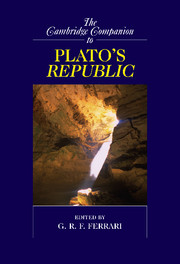Book contents
- Frontmatter
- 1 The Protreptic Rhetoric of the Republic
- 2 The Place of the Republic in Plato’s Political Thought
- 3 Rewriting the Poets in Plato’s Characters
- 4 Wise Guys and Smart Alecks in Republic 1 and 2
- 5 Justice and Virtue: The Republic’s Inquiry into Proper Difference
- 6 The Noble Lie
- 7 The Three-Part Soul
- 8 Eros in the Republic
- 9 The Utopian Character of Plato’s Ideal City
- 10 Philosophy, the Forms, and the Art of Ruling
- 11 Sun and Line: The Role of the Good
- 12 Beginning the “Longer Way”
- 13 The City-Soul Analogy
- 14 The Unhappy Tyrant and the Craft of Inner Rule
- 15 What Is Imitative Poetry and Why Is It Bad?
- 16 The Life-and-Death Journey of the Soul: Interpreting the Myth of Er
- Bibliography
- Index of Passages
- Index of Names and Subjects
- Series List
12 - Beginning the “Longer Way”
Published online by Cambridge University Press: 28 November 2007
- Frontmatter
- 1 The Protreptic Rhetoric of the Republic
- 2 The Place of the Republic in Plato’s Political Thought
- 3 Rewriting the Poets in Plato’s Characters
- 4 Wise Guys and Smart Alecks in Republic 1 and 2
- 5 Justice and Virtue: The Republic’s Inquiry into Proper Difference
- 6 The Noble Lie
- 7 The Three-Part Soul
- 8 Eros in the Republic
- 9 The Utopian Character of Plato’s Ideal City
- 10 Philosophy, the Forms, and the Art of Ruling
- 11 Sun and Line: The Role of the Good
- 12 Beginning the “Longer Way”
- 13 The City-Soul Analogy
- 14 The Unhappy Tyrant and the Craft of Inner Rule
- 15 What Is Imitative Poetry and Why Is It Bad?
- 16 The Life-and-Death Journey of the Soul: Interpreting the Myth of Er
- Bibliography
- Index of Passages
- Index of Names and Subjects
- Series List
Summary
I don't know yet. But we have set sail, and wherever the argument, like the wind, should bear us, there we must go.
Republic 394dAt 435c-d and again at 504b ff., Socrates indicates that there is a “longer and fuller way” that one must take in order to get “the best possible view” of the soul and its virtues. But in neither passage does Socrates take this “longer way.” At 435c-d he accepts Glaucon's plea to continue with the “methods” they have used so far, giving arguments “at that level.” In the text that follows his reminder at 504b ff. he restricts himself to an indirect indication of its goals by his images of sun, line, and cave and to a programmatic outline of its first phase, the five mathematical studies. If we stay within the dramatic context of the dialogue, we can see why Socrates offers such a partial and incomplete characterization. As keen and receptive as they are on political and ethical matters, Glaucon and Adeimantus are limited interlocutors on metaphysical issues; they have not undergone the mathematical education Socrates prescribes, and they are not in a position to raise critical questions about the Forms or the structure the Forms imply for city and soul. Accordingly, in his initial willingness to forgo the “longer way” (435d) and in his later very introductory account of it, Socrates measures his words to what Glaucon and Adeimantus are prepared to understand.
- Type
- Chapter
- Information
- The Cambridge Companion to Plato's Republic , pp. 310 - 344Publisher: Cambridge University PressPrint publication year: 2007
- 6
- Cited by

